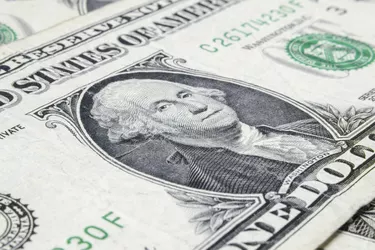
You may have heard a philosophy or even economics scholar claim that the U.S. dollar is inherently worthless. Even though it is the most powerful of the reserve currencies of the world, that statement is true; the dollar (like most currencies) by itself cannot meet essential needs, and therefore the government must establish its worth some other way. Historically, currency has been backed by something else with a set value.
Currency Backed by Gold
Video of the Day
For almost 200 years following the founding of the United States, the value of the U.S. dollar was officially backed by gold. The gold standard was a system agreed upon by many countries during that period, in which a currency was determined to be worth a certain amount of gold. This ended in 1914, according to the experts at Gold.org, and the U.S. gold-backed system ended in 1971 under an executive order by President Richard M. Nixon, but in actual fact, it had not been in practice for almost 40 years.
Video of the Day
During the Great Depression, President Franklin D. Roosevelt temporarily suspended the gold-backed system to allow the Federal Reserve to print more money to be in circulation and thereby alleviate shortages. It was a complex and controversial decision and the subsequent fiscal policy maneuvers essentially ended the gold standard in the United States.
How Is the U.S. Dollar Valued?
The Federal Reserve explains that United States currency has not been backed by gold in a long time, or redeemable for it since 1943. If not backed by anything, then how do we know the value of a dollar? It is true that no specific commodity backs the U.S. dollar. That doesn't mean that the Federal Reserve can print money without anything backing it up, though.
Due to both national and international statutes, the dollar must be backed up by something. Otherwise, the continued printing of money would only weaken the dollar's value instead of creating more wealth. The collateral on which the value of the dollar rests is complex and challenging to understand. Again, it is not based on commodities (gold, silver or even other less obvious commodities such as wheat or oil) but rather on securities exchanges, especially government-sponsored ones.
Another way of understanding it is that the U.S. government essentially promises that the dollar is worth what it says it is. Currency, therefore, is something of a promissory note from the government that indicates they have the means to convert every dollar in circulation into real wealth in some way. If this sounds risky and confusing to you, you're not alone; it is both a less easily understood and more complex way of establishing wealth. That being said, it has worked nationally and internationally for many decades.
Reserve Currencies of the World
Another fact about the U.S. dollar that's worth noting is that it is the top reserve currency in the world. A reserve currency is held in central banks or other monetary authorities (almost always government-owned) in foreign countries.
These reserve currencies help back up other money. So, for example, the Japanese Yen derives some of its value based on how many U.S. dollars Japan holds and vice versa. That's a relatively simple way of understanding it, but essentially what it creates is a truly global, interdependent monetary system. It's also what allows the U.S. dollar to be easily converted into other currencies used worldwide.
Much of this value is based on trade, which is why it is so essential for the U.S. to maintain its dominance in exports and trade. If it loses its place or slips behind, the dollar also loses value, which means everything we own also loses value. It also has the potential to destroy the global economy. As of July 2021, the countries holding the most reserve currency in the world are China, Japan, Switzerland, India and Russia.
Consider also: Classifications & Characteristics of Gold Exchange Standards